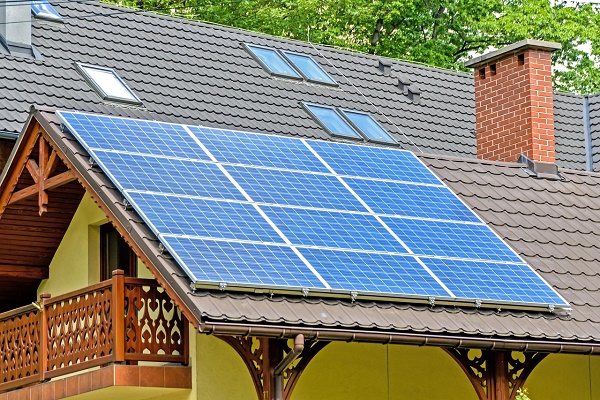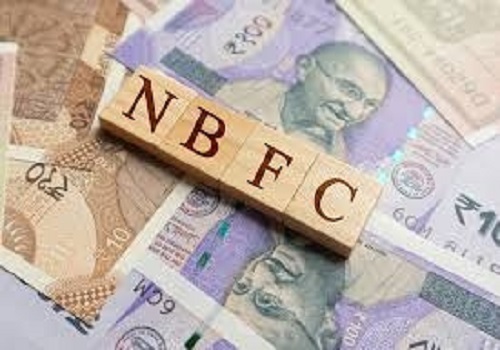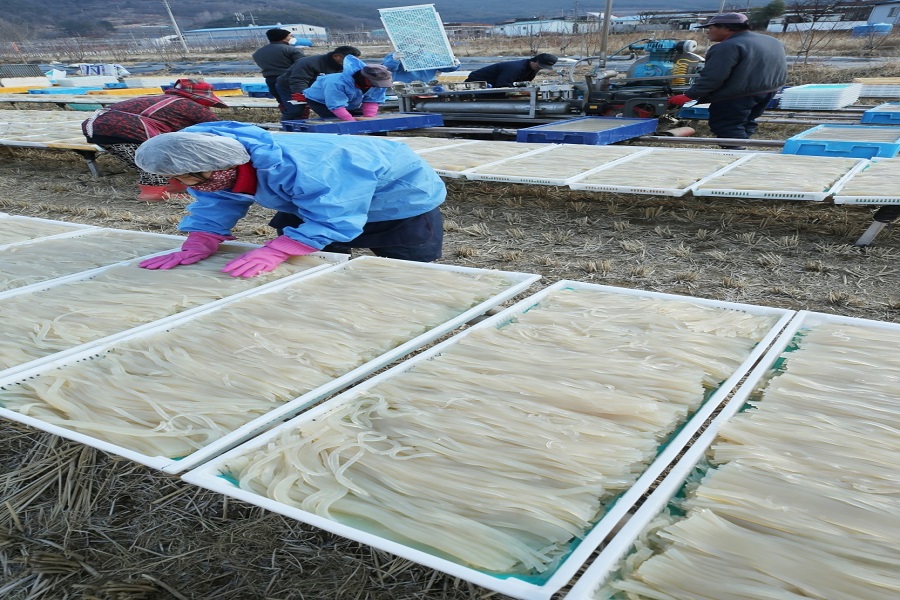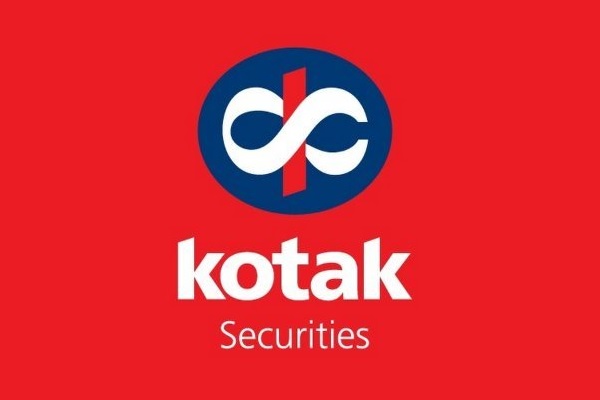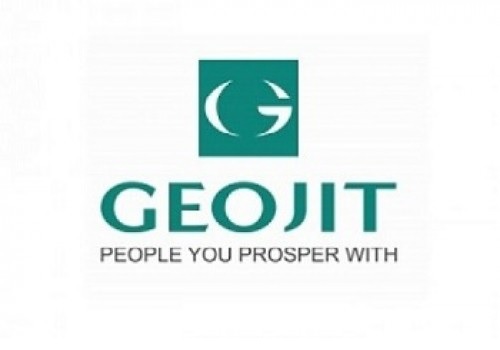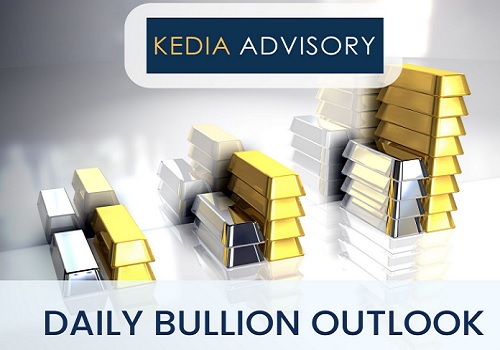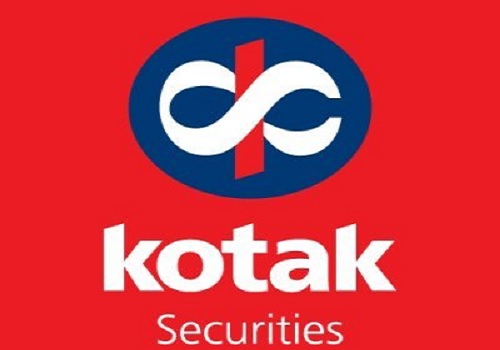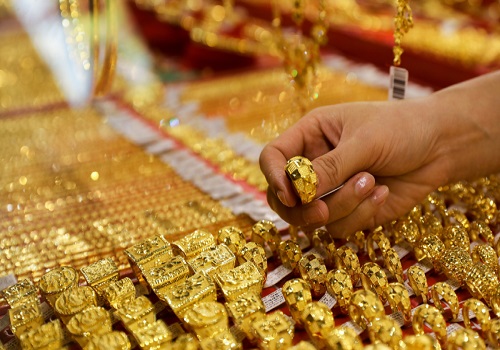Gold trading range for the day is 93805-96665 - Kedia Advisory

Gold
Gold surged by 2.36% to settle at Rs.95,661, driven by escalating fears surrounding the US-China trade war and its potential economic fallout. Market sentiment turned risk-averse after U.S. President Donald Trump reintroduced aggressive tariff threats, even after temporarily backing off on reciprocal tariffs for 90 days. While certain electronics like smartphones and computers were spared, heavy duties—up to 145%—remain in place for several Chinese imports, and further levies on semiconductors and pharmaceuticals are expected, injecting fresh uncertainty into global markets. In response to this volatility, safe-haven demand for gold surged. Physical demand strengthened in major Asian hubs due to recent price corrections. In China, gold premiums spiked to $24–$54/oz, up significantly from last week's $6–$13/oz range. Similarly, China’s central bank continued to bolster its gold reserves for a fifth straight month. India, however, witnessed mixed trends—with dealers initially charging premiums of $5/oz, which later turned into discounts of up to $33/oz due to subdued demand amid record-high prices. Looking ahead, India’s gold consumption in 2025 is expected to moderate to 700–800 metric tons from last year's peak of 802.8 tons. The surge in gold prices is likely to weigh on jewelry demand, which makes up nearly 70% of total demand. Technically, the market is under fresh buying with open interest rising by 8.56% to 22,449. Support is now at Rs.94,730, with further downside risk toward Rs.93,805. Resistance lies at Rs.96,160, and a breakout above that may lead to testing Rs.96,665.
Trading Ideas:
* Gold trading range for the day is 93805-96665.
* Gold hits 95000 amid fears of the US-China trade war escalation and its impact on the US economy remain unabated.
* US-China trade war escalates with 145% and 125% tariffs.
* Trump’s policy flip-flops raise economic uncertainty.
Silver
Silver prices climbed 1.56% to settle at Rs.96,250, fueled by renewed weakness in the U.S. dollar and mounting global economic concerns amid escalating trade tensions. The dollar index dropped to 99.6, its lowest in three years, as President Trump's new round of tariff threats—including critical minerals, pharmaceuticals, and semiconductors—added further strain to an already tense U.S.-China trade relationship. These policies have raised fears of a looming recession, prompting investors to move away from U.S. assets, thereby boosting safe-haven demand for silver. On the macroeconomic front, U.S. retail sales in March 2025 rose by a solid 1.4%, surpassing expectations and driven mainly by a surge in auto-related purchases ahead of impending tariffs. Manufacturing output also registered a 0.3% gain for the month, marking the fifth consecutive monthly increase. Despite this positive data, trade uncertainties continued to overshadow the economic outlook, benefiting commodities like silver. Fundamentally, the silver market remains undersupplied for the fifth straight year. In 2025, the global silver deficit is projected at 117.6 million ounces, narrowing by 21% from last year, as supply is expected to grow 2% while demand dips by 1%. Industrial demand is projected to hit a new record, surpassing 700 million ounces, driven by green energy applications. Technically, silver is undergoing short covering, with open interest falling 6.25% to 14,660. Key support lies at Rs.94,955, with deeper downside at Rs.93,660. Resistance is seen at Rs.97,255, and a breakout could lead to a test of Rs.98,260.
Trading Ideas:
* Silver trading range for the day is 93660-98260.
* Silver rallied as dollar resuming its slide to the lowest in three years.
* Prices got support as more trade barriers by President Trump pressured the US growth outlook.
* Retail sales in the US jumped 1.4% mom in March 2025, following a 0.2% gain in February.
Crude oil
Crude oil prices rose by 1.42% to close at Rs.5,341, supported by renewed optimism over potential U.S.-China trade negotiations and fresh production cut signals from Iraq. Baghdad's decision to lower output by 70,000 barrels per day in April to align with OPEC+ targets added bullish momentum to the market. However, the upside was capped amid broader concerns over sluggish global demand growth and mounting geopolitical and economic headwinds. The International Energy Agency (IEA) revised down its 2025 oil demand growth forecast by 70,000 barrels per day, now expecting only a 1 million bpd rise—marking the slowest pace in five years. The surplus between global supply and demand could hit 600,000 bpd, potentially increasing further if OPEC+ continues relaxing output curbs and fails to curb overproduction. The World Trade Organization also trimmed its forecast for global merchandise trade, warning of a severe slump driven by escalating U.S. tariffs, which echoes pandemic-era declines in global trade flows. In the U.S., the EIA reported a crude inventory build of 0.515 million barrels for the week ending April 11, above expectations, while Cushing stocks dropped by 654,000 barrels. Gasoline and distillate stocks also declined, indicating firm domestic fuel consumption despite broader economic uncertainties. On the technical front, crude oil is experiencing fresh buying interest, evidenced by a sharp 32.48% jump in open interest to 9,667 contracts. Immediate support is at Rs.5,225, with further downside risk to Rs.5,110. Resistance lies at Rs.5,415, and a breakout could push prices toward Rs.5,490.
Trading Ideas:
* Crudeoil trading range for the day is 5110-5490.
* Crude oil gains amid possibility of trade talks between China and the United States.
* Iraq aims to cut April output by 70,000 barrels per day in April in the face of pressure to meet its OPEC+ targets.
* Global oil demand will grow at its slowest for five years in 2025 – IEA
Natural gas
Natural gas prices fell by 2.66% to settle at Rs.277.7, weighed down by rising production levels and forecasts for milder weather that are expected to suppress heating demand. Average gas output in the Lower 48 U.S. states hit 106.3 billion cubic feet per day (bcfd) so far in April, slightly above the March record of 106.2 bcfd. Meanwhile, weather forecasts indicate warmer-than-normal temperatures persisting through April 29, which could further reduce residential heating needs and curb demand. Despite this, LNG export activity remains a bright spot, with flows to U.S. terminals hitting a record 16.3 bcfd in April, supported by ramp-up at Venture Global’s new Plaquemines facility in Louisiana. Storage data also added to the bearish tone. U.S. utilities injected 57 billion cubic feet (bcf) into storage for the week ending April 4, 2025—just below expectations of 60 bcf but well above the five-year average of 17 bcf. Storage levels are now 19.7% lower than a year ago and 2.1% below the five-year average, suggesting some underlying support for prices in the medium term. Looking ahead, the EIA projects both supply and demand to reach new records in 2025, with dry gas production at 104.6 bcfd and consumption at 90.7 bcfd. Technically, the market is under fresh selling pressure with open interest rising 5.49% to 23,985. Key support lies at Rs.273.7, with further downside to Rs.269.8. Resistance is at Rs.282.7, and a breakout could lead to testing Rs.287.8.
Trading Ideas:
* Naturalgas trading range for the day is 269.8-287.8.
* Natural gas fell due to rising production and mild weather forecasts.
* Average gas output in the Lower 48 US states rose to 106.3 billion cubic feet per day so far in April.
* Also, warmer-than-usual temperatures are expected to persist through April 29, reducing heating demand.
Copper
Copper prices edged higher by 0.47% to settle at Rs.843.45, buoyed by easing U.S. tariffs and renewed optimism surrounding economic stimulus in China, the world’s largest copper consumer. Recent signs of resilience in China’s economy, including stronger-than-expected Q1 growth driven by firm consumption and industrial output, lifted investor sentiment. Hopes for additional stimulus measures further supported the copper market amid ongoing trade headwinds from the United States. Citi raised its three-month copper price forecast to $8,800 per tonne from $8,000, citing tariff relaxation, Chinese buying on dips, and tight scrap supply due to U.S. stockpiling. However, the bank remains cautious over the medium term, anticipating slower consumption and manufacturing due to the 145% tariffs on Chinese goods. This has already led to a shift in refined copper flows from China to the U.S., reflected in China’s 1.4% year-on-year drop in March copper imports to 467,000 tonnes. Meanwhile, the International Copper Study Group (ICSG) reported a global refined copper market deficit of 19,000 metric tons in January, slightly easing from December's 22,000-ton deficit. Adjusted figures, including Chinese bonded warehouse inventories, show a smaller deficit of 17,000 metric tons in January. On the technical front, copper is experiencing short covering, with open interest falling 10.1% to 3,856 contracts while prices rose Rs.3.95. Immediate support is at Rs.833.5, with further downside risk to Rs.823.6. Resistance is seen at Rs.849.3, and a breakout above could lead to testing Rs.855.2.
Trading Ideas:
* Copper trading range for the day is 823.6-855.2.
* Copper gains amid optimism that China will launch additional stimulus measures.
* China's first-quarter economic growth beat expectations.
* China's imports of unwrought copper and copper products in March declined 1.4% to 467,000 tons from a year earlier.
Zinc
Zinc prices declined by 1.2% to settle at Rs.247.15 amid rising trade tensions between the U.S. and China, which overshadowed otherwise encouraging macroeconomic data from China. Despite China's Q1 economic growth exceeding expectations—driven by resilient consumption and strong industrial output—market sentiment was dampened by fears surrounding newly implemented U.S. tariffs, posing substantial headwinds to global trade and base metal demand. In terms of supply dynamics, China’s refined zinc production saw a notable increase in March 2025, rising nearly 14% month-on-month and over 4% year-on-year, following a period of lower production in February. The March rebound was fueled by an increase in operational days post-Lunar New Year and the recovery of smelting capacity in key provinces. Despite this, cumulative output for Q1 2025 remained down by more than 6% year-on-year. Meanwhile, global zinc fundamentals are also shifting; the market registered a smaller deficit of 10,000 metric tons in January, compared to 41,100 tons in December, according to ILZSG. Citi Research, acknowledging these changing fundamentals and tariff-related demand risks, revised its 2025 zinc price forecast downward to $2,630/t from $2,750/t. Production-related news remains mixed, with Nyrstar announcing a 25% output cut at its Hobart smelter in Australia and Red Dog Mine expected to reduce operations in 2025 as reserves decline. Immediate support lies at Rs.245.3, with further downside potential to Rs.243.3. Resistance is seen at Rs.249.3, with a move above that level possibly pushing prices toward Rs.251.3.
Trading Ideas:
* Zinc trading range for the day is 243.3-251.3.
* Zinc dropped as trade tensions between the United States and China rose.
* Citi has lowered its 2025 zinc price forecast to $2,630/t from $2,750/t.
* China's refined zinc production increased by nearly 14% MoM and over 4% YoY.
Aluminium
Aluminium prices edged marginally lower by 0.04% to settle at Rs.232.15, as escalating trade tensions between the U.S. and China weighed on sentiment and dampened expectations for global manufacturing demand. Market concerns were further heightened following the Trump administration’s move to sharply raise tariffs, prompting Goldman Sachs to lower its price forecast for aluminium to an average low of $2,000 per tonne in Q3 2025, citing a slowdown in global economic growth, especially in the U.S. and China. On the supply side, aluminium inventories at Japan’s three major ports declined by 1.2% in March to 309,700 metric tons, suggesting modest improvement in off-take. Meanwhile, China's aluminium output continues to rise, reaching 3.75 million metric tons in March, up 4.4% year-on-year, and totalling 11.07 million metric tons for Q1 2025—a 3.2% increase over the same period last year. However, given Beijing’s production cap of 45 million tons set back in 2017 to address oversupply and curb emissions, any further rise in output may be constrained moving forward. Citi, in contrast to Goldman Sachs, raised its Q2 aluminium price forecast to $2,300 per tonne from $2,200, expecting a quarterly average of $2,400 amid growing export volumes. Technically, aluminium is undergoing long liquidation, with open interest dropping 8% to 3,221 contracts. Prices may find immediate support at Rs.230.3, with further downside risk to Rs.228.4. On the upside, resistance is seen at Rs.233.4, and a break above could see prices testing Rs.234.6.
Trading Ideas:
* Aluminium trading range for the day is 228.4-234.6.
* Aluminium dropped as the trade war between the US and China pared expectations of manufacturing demand
* Citi raised its aluminium price forecast to $2,300 per tonne from $2,200 for the second quarter.
* China's aluminium production rose by 4.4 % to 3.75 million metric tons in March from a year earlier.
Cottoncandy
Cottoncandy futures declined by 0.51% to settle at Rs.54,750 amid profit booking, following recent gains driven by tightening domestic supply expectations. The Cotton Association of India (CAI) has revised its crop estimates downward by 4 lakh bales to 291.30 lakh bales of 170 kg each, citing lower output in Maharashtra. The earlier projection stood at 295.30 lakh bales. This downgrade stems from state-level reports as of March end, reinforcing concerns about a supply squeeze for the 2024-25 season. CAI estimates total cotton supply until March at 306.83 lakh bales, factoring in imports of 25 lakh bales and opening stocks of 30.19 lakh bales. End-March stockpiles stood at 127.83 lakh bales, with 27 lakh held by mills and the balance distributed among CCI, Maharashtra Federation, and traders. Despite the supply constraints, mill buying remains subdued due to comfortable inventory levels, capping further price upside. India’s cotton imports are forecasted to more than double to 33 lakh bales this season, up from 15.20 lakh last year, primarily due to weaker domestic output. Exports are projected to fall sharply to 16 lakh bales, down from 28.36 lakh bales in the previous season. Meanwhile, the U.S. cotton balance sheet saw minor adjustments—exports were reduced by 100,000 bales, raising ending stocks to 5 million bales. Technically, Cottoncandy is under fresh selling pressure as open interest rose 0.8% to 251 lots while prices dropped Rs.280. Immediate support lies at Rs.54,520, with further downside potential to Rs.54,290. Resistance is seen at Rs.54,990, and a breakout above could push prices toward Rs.55,230.
Trading Ideas:
* Cottoncandy trading range for the day is 54290-55230.
* Cotton dropped on profit booking after prices gained as CAI expects a shrinkage in the domestic crop
* CAI has estimated the total cotton supply till the end of March including the imports at 306.83 lakh bales.
* Cotton exports for the 2024-25 season are pegged at 16 lakh bales, lower by 12.36 lakh bales
* In Rajkot, a major spot market, the price ended at 25741.45 Rupees dropped by -0.5 percent.
Turmeric
Turmeric yesterday settled down by -0.33% at 14,948 due to the absence of follow-up buying after a speculative surge in prices last week. While total arrivals increased to 66,560 bags from 59,084 bags in the previous session, indicating improved supplies, the market remained cautious. A significant rise in arrivals was seen particularly in Basmathnagar and Sangli, where supply volumes surged. However, the downside pressure on prices was limited due to continued strong buying interest driven by lower-than-expected arrivals, which kept supplies tight. The export market showed positive trends, with turmeric exports for the period of April-January 2025 rising by 12.93% to 148,690.78 tonnes compared to the same period in 2024. Exports in January 2025 were higher than in January 2024, reflecting a steady demand. However, a drop in exports was observed in January 2025 compared to December 2024, which dampened immediate bullish sentiment. Concerns about lower crop yields due to untimely rains were a key factor limiting production despite an increase in planting area. The area under turmeric this season rose by 10% to 3.30 lakh hectares, but production is expected to decrease by 10-15%, particularly in regions like Nanded, due to adverse weather conditions. Technically, turmeric is under fresh selling pressure as open interest increased by 1.55% while prices fell by -50 rupees. Support is at 14,698, and a breach could see prices testing the 14,448 levels. On the upside, resistance is seen at 15,230, and a move beyond this could lead to prices testing 15,512.
Trading Ideas:
* Turmeric trading range for the day is 14448-15512.
* Turmeric dropped due to lack of follow-up buying and rise in arrivals.
* Total arrivals rose to 66,560 bags from 59,084 bags in the previous session, indicating better supplies.
* There were concerns over slow growth of rhizomes and low yield estimates persist.
* In Nizamabad, a major spot market, the price ended at 14767.7 Rupees gained by 1.71 percent.
Jeera
Jeera yesterday settled down by -1.89% at 24,145 as demand from stockists weakened amid elevated price levels, and continued selling by farmers weighed on the market sentiment. The market experienced a decrease in prices despite the tight near-term supply, primarily due to a delay in the arrival of the new crop from Gujarat, which is facing adverse weather conditions. The sowing of cumin in key producing states like Gujarat and Rajasthan has been delayed by about a month, contributing to the supply constraint. India's cumin production has increased significantly to 8.6 lakh tonnes from 11.87 lakh hectares during 2023-24, compared to 5.77 lakh tonnes from 9.37 lakh hectares in the previous year. This increase in production is a positive development, although the delay in the new crop's arrival may impact the immediate supply. Furthermore, India remains the cheapest supplier of cumin globally, making it the primary exporter, especially to countries like China. The rising demand for cumin due to festive seasons and tensions in the Middle East has also boosted exports, with India’s cumin exports rising by 66.98% from April to January 2025, compared to the same period in the previous year. Technically, the market is under fresh selling pressure, as evidenced by the 2.74% increase in open interest and a drop of -465 rupees in prices. Jeera is getting support at 24,000, and if it fails to hold, a further drop to 23,850 is possible. Resistance is now seen at 24,350, and a move above this level could push prices towards 24,550.
Trading Ideas:
* Jeera trading range for the day is 23850-24550.
* Jeera dropped as demand from stockists weakened amid elevated price levels.
* The current season is expected to have similar production levels as last year due to better crop conditions and good sowing.
* Jeera exports during Apr - Dec 2024, rose by 70.72 percent at 165,084.40 tonnes as compared to 96,701.43 tonnes exported during Apr- Dec 2023.
* In Unjha, a major spot market, the price ended at 24516.65 Rupees dropped by -0.27 percent.
Views express by all participants are for information & academic purpose only. Kindly read disclaimer before referring below views
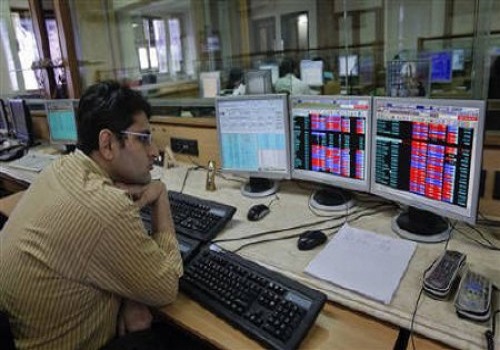



.jpg)


